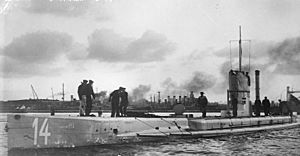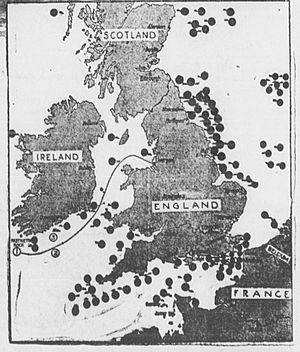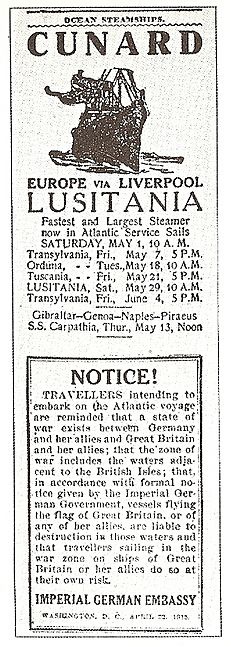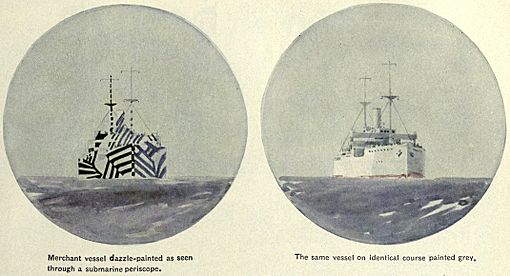U-boat campaign facts for kids
Quick facts for kids U-boat campaign |
|||||||
|---|---|---|---|---|---|---|---|
| Part of the naval theatre of World War I | |||||||
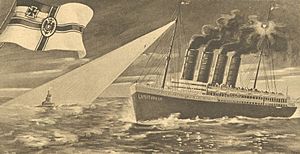 A German postcard depicting the U-boat SM U-20 sinking RMS Lusitania |
|||||||
|
|||||||
| Belligerents | |||||||
| Commanders and leaders | |||||||
| Strength | |||||||
| ? surface vessels 366 Q-ships |
351 U-boats | ||||||
| Casualties and losses | |||||||
| 5,000 merchant ships sunk 15,000 merchant sailors killed 104 warships sunk 42 warships damaged 61 Q-ships sunk |
217 U-boats lost to all causes 6,000 sailors killed |
||||||
The U-boat campaign from 1914 to 1918 was a major part of World War I at sea. German U-boats, which were submarines, attacked ships carrying supplies for the Allied countries. Most of these battles happened around the British Isles and in the Mediterranean Sea.
Both the German Empire and the United Kingdom needed to import food and raw materials for their war efforts. Each side tried to stop the other's supplies. Britain's Royal Navy was much larger and could operate worldwide. Germany's surface fleet was mostly stuck near home. So, Germany used U-boats to attack enemy shipping everywhere else.
During the war, German U-boats sank nearly 5,000 ships. These ships carried about 13 million tons of goods. Germany lost 178 U-boats and about 5,000 sailors in these battles. U-boats also operated in the Far East, Indian Ocean, and North Seas.
Contents
1914: Early U-boat Battles
North Sea: First Attacks
In August 1914, ten German U-boats left their base to attack British warships. This was the first submarine war patrol ever. Their goal was to sink large British battleships. This would make the British fleet less powerful than the German one.
The first mission was not very successful. One U-boat had engine trouble and returned. Only one torpedo was fired, and it missed. Two of the ten U-boats were lost.
Later that month, U-boats had more success. U-21 sank the British cruiser HMS Pathfinder. In September, U-9 sank three armored cruisers in one battle. These were Aboukir, Hogue, and Cressy.
More victories followed for the U-boats. In October, U-9 sank another cruiser, Hawke. U-27 sank the British submarine E3. This was the first time one submarine sank another. By the end of 1914, U-boats had sunk nine warships. They had lost five of their own.
Mediterranean: Early Actions
In the Mediterranean, the Austro-Hungarian Navy's U-boats fought the French. The French were blocking the Straits of Otranto. Austria-Hungary had seven U-boats at the start of the war. These were small and had limited range.
During the war, new, larger U-boats arrived. Germany also sent some U-boats overland to the Mediterranean. Austro-Hungarian U-boats had some successes. In December 1914, U-12 torpedoed the French battleship French battleship Jean Bart. In April 1915, U-5 sank the French cruiser French cruiser Léon Gambetta. Many lives were lost.
How Submarines Fought
In 1914, the U-boat's main strength was its ability to dive underwater. Surface ships could not find or attack submarines underwater. U-boats also had torpedoes, which could sink a large warship with one hit.
However, U-boats had weaknesses. Underwater, they were almost blind and slow. They had limited speed and could not stay submerged for long. Even on the surface, their speed was slower than most warships. This meant they had to be in the right place before an attack.
U-boats achieved some impressive wins. They even forced the British Grand Fleet to find a safer base. But the German Navy could not reduce the Grand Fleet's overall strength. U-boats also failed to help in the main surface battles. Warships moving fast and in zig-zag patterns were hard to hit. U-boats could not successfully attack them this way for the rest of the war.
First Attacks on Merchant Ships
U-boats began attacking merchant ships in October 1914. At first, there was no big plan to attack Allied trade. It was known that U-boats had problems as trade raiders. Also, such attacks could upset neutral countries. In the six months before February 1915, U-boats sank 19 merchant ships.
1915: War on Trade Ships
Unrestricted Submarine Warfare Begins
By early 1915, everyone realized the war would not end quickly. Countries started to use harsher methods.
Britain used its strong navy to block Germany's ports in August 1914. In November 1914, Britain declared the North Sea a war zone. Any ships entering did so at their own risk. Even food was considered "contraband" (illegal goods). Germany saw this as an attempt to starve its people. They wanted to strike back.
Germany could not match Britain's navy on the surface. The only way Germany could block Britain was with U-boats. The German leader, Theobald von Bethmann Hollweg, worried that sinking ships without warning would anger the United States. But he could not stop the pressure to do so.
On February 4, 1915, Admiral Hugo von Pohl announced a "War Zone." This zone included the waters around Britain and Ireland. He warned that enemy merchant ships in this zone would be destroyed. Neutral ships would also be at risk.
This new policy was called "unrestricted submarine warfare." It would eventually bring countries like the United States into the war. German U-boats were now based in Belgium, giving them better access to English shipping lanes. About 20 U-boats began the naval blockade.
In January, before this new policy, U-boats sank about 43,550 tons of shipping. This number grew steadily. In August, 168,200 tons were sunk. German U-boats sank nearly 100,000 tons per month. This was an average of 1.9 ships daily.
The Sinking of RMS Lusitania
On May 7, 1915, the passenger ship RMS Lusitania was torpedoed by U-20. It sank in just 18 minutes off the coast of Ireland. Of the 1,959 people on board, 1,199 died. This included 128 US citizens.
Germany tried to explain why they sank the ship. But there was huge anger in Britain and America. Many in Britain felt the US had to declare war. US President Woodrow Wilson did not want to rush into war.
Wilson had warned Germany that the US would hold them responsible for any harm to American rights. He sent three strong messages to Germany. These messages said Americans had the right to travel on merchant ships. They also demanded Germany stop submarine warfare against commercial vessels.
Germany argued that the British blockade was illegal. They also claimed Lusitania was carrying weapons. Wilson rejected these arguments. His Secretary of State, William Jennings Bryan, resigned because he thought Wilson's message was too strong.
Wilson's third message was an ultimatum. It said any future sinkings would be seen as "deliberately unfriendly." The American public was not ready for war yet. But the sinking of Lusitania put the US on a path toward joining the war.
A Pause in Unrestricted Warfare
On August 19, 1915, U-24 sank the passenger liner SS Arabic. This happened off the coast of Ireland. Forty-four people died, including three Americans. Many thought the US would cut ties with Germany.
So, on August 28, Germany changed its orders. All passenger ships could only be sunk after a warning. Passengers and crews had to be saved. By September 1, unrestricted submarine warfare was mostly stopped in the Atlantic. This was not popular with the German Navy. So, on September 18, the U-boat fleets were pulled back from attacking trade ships in the Atlantic.
Mediterranean Operations Continue
The Mediterranean Sea was a good place for German U-boats to operate. Many British, French, and Italian imports passed through it. Submarines could also work there even in bad weather. There were also narrow points, like the Suez Canal, where ships had to pass. Fewer neutral ships (like from the US) were in the Mediterranean.
Throughout the summer of 1915, Germany sent U-boats to the Mediterranean. The campaign began in October 1915. U-boats like U-33 and U-39 attacked shipping. That month, 18 ships were sunk.
In November 1915, U-38 sank the Italian ship SS Ancona. It was sailing under the Austrian flag. Nine American citizens died. This caused another diplomatic problem. The "sinking without warning" policy was stopped again in April 1916. It would not restart until 1917. Another similar event in March 1916 helped push Italy to declare war on Germany in August 1916.
Allied Countermeasures
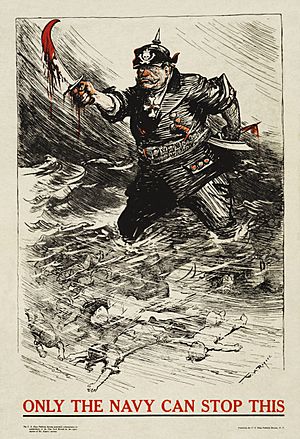
Allied efforts to fight U-boats had mixed results. Arming merchant ships was one effective defense. Ships were told to either run away or turn towards the U-boat to ram it. This would force the U-boat to dive.
The next step was to arm ships to fight U-boats. Two U-boats were sunk in 1915 by armed trawlers. Then came "Q-ships." These were armed ships with hidden guns. They looked like regular merchant ships. Two U-boats were sunk by Q-ships in 1915. Two more were sunk by submarines escorting trawlers.
Offensive measures were less successful. Attempts to use nets or explosives to find and destroy U-boats mostly failed. Efforts were also made to block routes like the Straits of Dover with nets and mines. This was called the Dover Barrage. Mines were also laid around U-boat bases. These efforts cost a lot but had little success. Only two U-boats were sunk this way in 1915.
In six months of unrestricted submarine warfare, U-boats sank about 750,000 tons of Allied shipping. This did not seriously hurt the British merchant fleet. New ships were built, and captured ships were added.
However, Germany had angered neutral countries like Norway and the Netherlands. It also brought the United States close to war. Because of these problems, and new rules, the U-boat campaign in the Atlantic mostly stopped. It continued in the Mediterranean and other areas.
In 1917, Britain started using dazzle camouflage on ships. This was meant to confuse U-boat commanders. The results were not clear.
Depth Charges Developed
The depth charge was first thought of in 1910. It became real when the British Royal Navy asked for it in 1914. The first effective depth charge, called "Type D," was ready in January 1916.
At first, anti-submarine ships carried only two depth charges. These were dropped from the back of the ship. The first U-boat sunk by a depth charge was U-68 in March 1916. It was sunk by the Q-ship Farnborough. Germany learned about depth charges after some failed attacks. Only two other U-boats were sunk by depth charges in 1916.
1916: U-boats in Many Seas
Supporting the German Fleet
In 1916, Germany tried again to use U-boats to weaken the British Grand Fleet. They set up U-boat traps. The German battle fleet would try to lure the British fleet into these traps.
Several such operations were tried in March and April 1916, but they failed. The biggest fleet battle, the Battle of Jutland in May 1916, had no U-boat involvement. The fleets met by chance, and no U-boats were nearby. More operations in August and October 1916 also failed. So, Germany decided to go back to attacking trade ships.
The British knew about the risk of U-boat traps. But they did not know where they might be. The British commander, Jellicoe, had a plan. If the German fleet turned away, he would assume it was a U-boat trap. He would not follow directly. Instead, he would move fast to the side. This would force any U-boats to surface if they wanted to follow.
Mediterranean Waters
In 1916, the war on trade ships continued in the Mediterranean. Allied efforts to stop U-boats were not very effective. Different navies had trouble working together. The main Allied solution, the Otranto Barrage, did not work well.
Only two U-boats were caught in the barrage during the whole war. Meanwhile, merchant ships suffered huge losses. In 1916, the Allies lost 415 ships in the Mediterranean. This was half of all Allied ships sunk in all war areas that year.
Many of the best U-boat commanders served in the Mediterranean. This included Lothar von Arnauld de la Perière, who sank the most ships of any commander.
American Waters
In 1916, Germany built two merchant submarines. These were used to sneak valuable goods past the British blockade. The first, Deutschland, sailed in summer 1916. It made a good impression on the US public. It made a second successful trip later that year. Its sister ship, Bremen, disappeared on its first voyage.
Another U-boat, U-53, made a less positive impression. After getting fuel in Rhode Island, it attacked Allied ships off the US coast. This was in international waters, and the U-boat followed the rules. But Americans saw it as an insult. US warships had to stand by while merchant ships nearby were sunk.
Arctic and Black Sea Waters
In autumn 1916, U-boats attacked ships going to Russia in the Barents Sea. They sank 34 ships before winter ice stopped operations. Two U-boats also laid mines in the White Sea.
In the Black Sea, the Constantinople Flotilla operated U-boats. Bulgaria joined in May 1916. In three years, this group sank over 117,000 tons of shipping. Some U-boats were lost to Russian mines or aircraft.
1917: Unrestricted Submarine Warfare Returns
In December 1916, Admiral Henning von Holtzendorff wrote an important paper. He suggested restarting unrestricted U-boat warfare in 1917. Holtzendorff believed that sinking 600,000 tons of shipping per month would defeat Britain in six months. He thought this would happen before America could act. He promised the Kaiser that "not one American will land on the Continent."
On January 9, 1917, the Kaiser met with his leaders. Germany's war situation was bad. The fighting in France was stuck. Allied forces outnumbered German ones. The British blockade was causing food shortages and deaths in Germany. Military leaders pushed the Kaiser to use U-boats against Britain. On January 31, the Kaiser ordered unrestricted submarine warfare to restart on February 1.
Germany had 105 submarines ready for action on February 1. New U-boats were being built. This meant at least 120 submarines would be available all year. The campaign was very successful at first. Nearly 500,000 tons of shipping were sunk in February and March. In April, 860,000 tons were sunk. Britain's wheat supply dropped to only six weeks' worth. Losses stayed high in May and June. Germany lost only nine submarines in the first three months.
On February 3, President Wilson cut off all diplomatic ties with Germany. On April 6, the US Congress declared war.
1918: The Final Year
By the end of 1917, Allied shipping losses were over 6 million tons for the year. However, monthly losses had dropped. They never reached the high levels of spring 1917 again.
The Allies started using a full convoy system. This meant merchant ships traveled in groups, protected by warships. This greatly reduced Allied shipping losses. At the same time, U-boat losses went up. Germany lost 61 U-boats by the end of 1917, compared to 48 before February 1917.
The U-boat commanders tried to attack convoys in groups, but it was hard to control them at sea. One attempt in May 1918 with six U-boats sank three ships. But two U-boats were lost, including one rammed by the troopship Olympic. This failure stopped further group attacks.
U-cruisers and American Campaign
Late in the war, Germany sent large U-boats, called U-cruisers, to attack the US coast. These were the Type U-151 and Type U-139 U-boats. They carried many torpedoes and large deck guns. They could travel very long distances. Seven Type U-151 and three Type U-139 U-boats were built. Some were originally merchant submarines.
U-151 left Germany in April 1918 to attack American shipping. In May, it laid mines off the US coast. It also cut underwater telegraph cables. In June 1918, U-151 sank six US ships and damaged two others off New Jersey. This day became known as "Black Sunday." Only 13 people died in these sinkings. U-151 returned to Germany after a 94-day trip. It had sunk 23 ships and laid mines that sank 4 more.
Other U-cruisers were sent, but the US Navy was ready. The hunting was not as good. U-156 was lost on its way back to Germany. Other long-range U-boats were still crossing the Atlantic when the war ended in November 1918.
In July 1918, a U-boat attacked the town of Orleans, Massachusetts. It sank four barges and a tugboat. The U-boat fired on the town for about an hour. Two Navy planes fought it off. This was the first time a foreign power's artillery attacked US soil since the Mexican-American War.
Final Countermeasures
By 1918, Allied anti-submarine efforts were much better. Aircraft became very useful for patrolling large areas. While planes rarely sank U-boats, their presence forced U-boats to dive. This made them blind and unable to move quickly. Aircraft could also call warships to the scene. In 1918, no convoy with air patrol lost a ship. U-boats had to operate at night or far from aircraft.
In 1918, the US Navy started a huge project. They laid over 70,000 mines in the North Sea Mine Barrage. This blocked routes out of the North Sea. From September to November 1918, six U-boats were sunk by these mines.
The British Royal Navy also developed the R-class submarine. These were designed to hunt and kill other submarines. They had high underwater speed and good listening systems. But they came too late to see much action.
By the end of 1918, Allied shipping losses were much lower. However, 69 submarines were lost that year. This was the U-boat force's worst year.
During World War I, the United States Navy fought German submarines. They also escorted convoys. American ships arrived in Ireland in May 1917. They were ready for patrol right away. Most US destroyers and submarines were sent to Europe. They had bases in Ireland, the Azores, and other places. They had many contacts and attacks with U-boats. Only two U-boats were sunk or disabled by American action.
American submarine chasers also fought Austro-Hungarian forces. They helped sink two Austro-Hungarian destroyers in Albania.
Japanese Participation
Starting in April 1917, Japan, an ally of Britain, sent 14 destroyers to the Mediterranean. They were based in Malta. They helped escort convoys and guard against enemy submarines. Japanese ships were very good at patrolling and anti-submarine work. However, no Austro-Hungarian submarines were sunk by the Japanese navy. Japan lost one destroyer, Sakaki, which was torpedoed by U-27.
Brazilian Participation
In December 1917, Britain asked for a Brazilian naval force. A squadron of Brazilian ships was formed. This group sailed in July 1918. On August 25, they thought they were attacked by a U-boat. One ship fired depth charges and thought it sank the submarine. But this sinking was never confirmed.
The Brazilian force patrolled an area where U-boats were thought to wait for convoys. They arrived in Gibraltar in November 1918. While passing through the Straits of Gibraltar, they mistook three US Navy ships for U-boats. No damage was caused.
Aftermath
By mid-1918, U-boat losses were too high. The morale of their crews dropped a lot. By autumn, it was clear that Germany and its allies could not win the war.
The Allies demanded that Germany surrender all its submarines. This was a condition for an armistice (peace agreement). On October 24, 1918, all German U-boats were ordered to stop fighting and return to port. The Allies said all working submarines had to be given to them. Those in shipyards had to be broken up.
More than 160 U-boats surrendered in Harwich, England, in November 1918. The German crews were sent home without touching British soil. Some U-boats were put on display. Others were left on beaches. The last role for U-boats in World War I was helping to stop a German naval mutiny. They were ready to "fire without warning on any vessel flying the red flag" (meaning, rebelling).
Summary
Allied and Neutral Tonnage Sunk by U-boats in World War I
| Month | 1914 | 1915 | 1916 | 1917 | 1918 |
|---|---|---|---|---|---|
| January | 47,981 | 81,259 | 368,521 | 306,658 | |
| February | 59,921 | 117,547 | 540,006 | 318,957 | |
| March | 80,775 | 167,097 | 593,841 | 342,597 | |
| April | 55,725 | 191,667 | 881,027 | 278,719 | |
| May | 120,058 | 129,175 | 596,629 | 295,520 | |
| June | 131,428 | 108,851 | 687,507 | 255,587 | |
| July | 109,640 | 118,215 | 557,988 | 260,967 | |
| August | 62,767 | 185,866 | 162,744 | 511,730 | 283,815 |
| September | 98,378 | 151,884 | 230,460 | 351,748 | 187,881 |
| October | 87,917 | 88,534 | 353,660 | 458,558 | 118,559 |
| November | 19,413 | 153,043 | 311,508 | 289,212 | 17,682 |
| December | 44,197 | 123,141 | 355,139 | 399,212 | |
| Total | 312,672 | 1,307,996 | 2,327,326 | 6,235,878 | 2,666,942 |
Grand Total: 12,850,815 gross tons of shipping were sunk.
Allied losses included 10 battleships, 18 cruisers, and many smaller naval ships.
Unrestricted submarine warfare started again in February 1917. Britain began using full convoy systems in September 1917. The highest losses happened in April 1917, when a record 881,027 tons were sunk.
German Submarine Force 1914–1918
| 1914 | 1915 | 1916 | 1917 | 1918 | |
|---|---|---|---|---|---|
| On hand | 24 | 29 | 54 | 133 | 142 |
| Additions (Commissioned) | 10 | 52 | 108 | 87 | 70 |
| Battle losses | 5 | 19 | 22 | 63 | 69 |
| Other losses | 8 | 7 | 15 | 9 | |
| Years end | 29 | 54 | 133 | 142 | 134 |
- Total U-boats built and used: 351
- Total sunk in combat: 178 (41 by mines, 30 by depth charges, 13 by Q-ships)
- Other losses (not in combat): 39
- Completed after the war ended: 45
- Surrendered to Allies: 179
- Men lost in U-boats: 5,15 officers and 4,894 enlisted men
The most successful U-boat commanders of World War I were Lothar von Arnauld de la Perière, Walter Forstmann, and Max Valentiner. They sank hundreds of ships. Their records have never been beaten in any later war.


